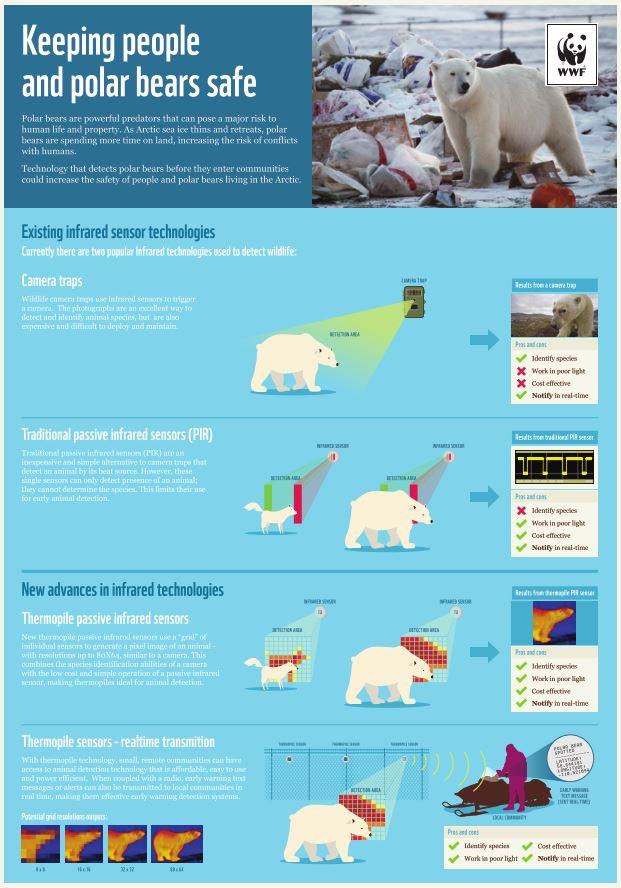Early detection of animals nearing human settlements is an effective way to resolve the increasing conflict between humans and wildlife. Electric fences, human patrols, and remote imaging are all popular methods of detection used many communities. They work well in many situations, but they can be expensive, labor intensive or difficult to maintain. Where appropriate, replacement with a low cost, automated monitoring solution can increase the scope and effectiveness of early detection systems. Our partnership with WWF and WILDLABS focuses on early detections of elephants, polar bears and tigers, but our goal is to create a detection system that could be trained to detect many more species across the globe.
Goal
Build and deploy an early detection system that will:
- Identify the target species
- Be cost effective
- Be easy to maintain
- Alert in real-time
- Work at small or large scales
Species identification and cost effectiveness are especially key. If you can’t identify the species, you can’t send an alert that it’s nearby. If the system isn’t cost effective, it will be limited to high income communities, which are a minority across the globe. Capturing an image of the animal is the easiest way to accurately identify the species, but many imaging techniques are expensive and require the species to be identified manually. However, new advances in infrared technology could provide a solution.

Our Idea
Combine a series thermopile passive infrared (PIR) sensors with a computer recognition algorithm to automatically identify and send community alerts when a specific animal is detected.
To understand why thermopile PIR sensors were chosen, let’s take a look at three commonly used detection techniques: Optical cameras, traditional PIR sensors and forward-looking infrared (FLIR) cameras.
Optical cameras produce excellent images for species identification, but they are expensive and difficult to maintain. They also often perform poorly in low light conditions and adverse weather, limiting their use. Infrared sensors detect animals through their heat signature and work regardless of light conditions. Traditional PIR sensors can detect an animal’s presence by the change in heat as they pass by a sensor, but this is recorded as a pulse, not a pixel image. While they are cost-effective, they cannot be programmed to identify a certain species. High-resolution forward-looking infrared (FLIR) cameras produce very high resolution thermal images and are excellent for species identification, but that resolution comes at a cost that is unaffordable for many communities, especially if several cameras are needed to monitor large areas.
Thermopile PIR sensors are configured in an array, which can generate a pixel image. This combines the low cost of PIR sensors with the ability to identify a species. Thermopiles are small, easy to operate, easy to maintain and move and are power efficient. Though the resolution of a thermopile PIR sensor is lower than a FLIR camera, we believe it is sufficient to train a computer algorithm to recognize a target species and send an alert. The low cost of thermopile PIR sensors makes them suitable for deployment in a series, with several thermopiles detecting at different angles to increase confidence in species identification. This also makes them suitable for monitoring large areas that require many sensors.
Our Plan
Our initial tests will use several Heimann sensors thermopile arrays with different resolutions and fields of view (FOV).
| Product | Company | Model | Resolution | FOV° | Lens Material |
|---|---|---|---|---|---|
| Thermopile Array | Heimann | HTPA32x32dL2.1 | 32 x 32 | 90 x 90 | Silicone |
| Thermopile Array | Heimann | HTPA32x32dL5.0 | 32 x 32 | 33 x 33 | Germanium |
| Thermopile Array | Heimann | HTPA90x64dL5.0 | 80 x 64 | 88 x 70 | Germanium |

Heimann thermopile array sensors
Preliminary testing was conducted in Antarctica, testing the ability of the sensor to detect penguins in cold temperatures. Testing for our target species will being spring 2018 in zoo habitats, where we can test different thermopile models and arrangements to determine what is best for recognizing each animal species. Data collected during zoo testing will also train the computer recognition algorithm. We will use optical cameras to check accuracy of the algorithm and identify times the sensor did not detect an animal. The final sensor will comprise of a thermopile array sensor, a microprocessor with the recognition algorithm, a ShadowView long range (LoRa) radio to send alerts and a li-ion rechargeable battery. Field tests will be started in the fall of 2018, beginning with polar bears and elephants.

Preliminary testing was conducted in Antarctica, testing the ability of the sensor to detect penguins in cold temperatures. (Credit: Alasdair Davies)
Where are we now?
We are currently purchasing equipment and reaching out to zoos for potential test sites. We will continue to post blogs on WILDLABS and WWF about our successes and failures, so check back to see our progress. With our open-source philosophy, we welcome feedback, questions or suggestions. Sharing knowledge will help us build a better system, better protect humans and wildlife and promote effective and open solutions for all of conservation technology.
Want more information? Read our infographic about applying this system to polar bear conflict in the arctic!
About the Author
Anne Dangerfield is a project manager for the human-wildlife conflict project with the Arribada Initiative, dedicated to affordable, open-source conservation technology solutions.




Add the first post in this thread.